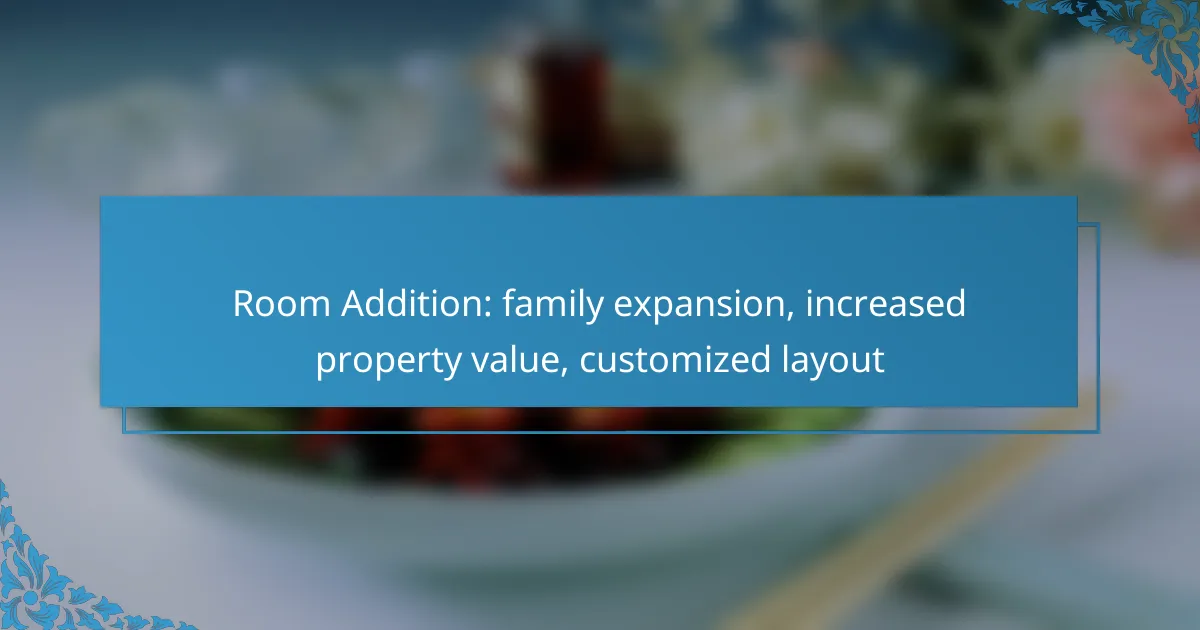Room additions are an excellent way to enhance family life by providing extra space, improving comfort, and boosting property value. By customizing layouts to fit specific needs, homeowners can create functional and enjoyable living environments that cater to their growing families.

How can room additions benefit families in Toronto?
Room additions can significantly enhance family life in Toronto by providing more space, improving comfort, and increasing property value. These expansions allow families to customize their living environments to better suit their needs, making homes more functional and enjoyable.
Increased living space
Adding a room can dramatically increase the living space available to a family, accommodating growing needs such as additional bedrooms or play areas. In Toronto, where real estate can be expensive, this expansion can be a cost-effective alternative to moving to a larger home.
Consider the potential of converting an attic or basement into a livable area. This can add anywhere from 200 to 1,000 square feet, depending on the existing structure and local building regulations.
Enhanced family comfort
Room additions can enhance family comfort by creating dedicated spaces for various activities, such as a home office, gym, or entertainment room. This separation allows family members to enjoy their interests without disturbing one another.
For instance, a well-designed family room can serve as a cozy gathering place, while a separate study can provide a quiet environment for work or study. This tailored approach can lead to a more harmonious living situation.
Improved functionality
With a room addition, families can improve the functionality of their homes by designing spaces that meet their specific needs. Whether it’s adding a mudroom for storage or a larger kitchen for cooking and entertaining, these enhancements can streamline daily routines.
When planning a room addition, consider how the new space will integrate with existing areas. For example, an open-concept design can facilitate better flow and accessibility, making the home more user-friendly for everyone.

What are the costs associated with room additions in Ontario?
The costs associated with room additions in Ontario can vary significantly based on several factors, including size, design, and local regulations. Homeowners should expect to budget for construction materials, labor, and permits, which can collectively impact the overall expense of the project.
Average cost per square foot
The average cost per square foot for room additions in Ontario typically ranges from CAD 200 to CAD 400, depending on the complexity of the design and materials used. More elaborate designs or high-end finishes can push costs even higher.
When planning your budget, consider that larger additions may benefit from economies of scale, potentially lowering the cost per square foot. It’s advisable to obtain multiple quotes from contractors to ensure competitive pricing.
Permitting fees
Permitting fees for room additions in Ontario can vary by municipality but generally range from CAD 500 to CAD 2,000. These fees cover the cost of reviewing your plans and ensuring compliance with local building codes and zoning regulations.
Before starting your project, check with your local building department to understand the specific requirements and fees applicable to your area. This can help you avoid unexpected costs and delays during the construction process.
Contractor labor rates
Contractor labor rates in Ontario for room additions typically range from CAD 50 to CAD 150 per hour, depending on the contractor’s experience and the project’s complexity. Skilled tradespeople may charge higher rates, especially for specialized work.
It’s beneficial to discuss labor costs upfront and clarify what is included in the rate. Some contractors may offer a flat fee for the entire project, which can provide more predictable budgeting compared to hourly rates.

What types of room additions are popular in Canada?
In Canada, popular room additions include family rooms, master suites, and sunrooms. These additions not only enhance living space but also increase property value and allow for customized layouts to suit family needs.
Family rooms
Family rooms are designed as communal spaces for relaxation and entertainment. They often feature open layouts that connect with kitchens or dining areas, making them ideal for family gatherings.
When planning a family room addition, consider factors such as size, natural light, and access to outdoor spaces. Typical costs for a family room addition in Canada can range from CAD 50,000 to CAD 100,000, depending on materials and design choices.
Master suites
Master suites provide a private retreat for homeowners, often including a bedroom, walk-in closet, and en-suite bathroom. This type of addition enhances comfort and can significantly boost property value.
When adding a master suite, focus on layout and amenities that cater to your lifestyle. Costs can vary widely, typically falling between CAD 100,000 and CAD 200,000, depending on the complexity of the design and finishes.
Sunrooms
Sunrooms are versatile spaces that allow for year-round enjoyment of natural light and outdoor views. They can serve various purposes, from casual living areas to home offices or playrooms.
Consider the orientation of the sunroom to maximize sunlight while minimizing heat loss in winter. The cost for a sunroom addition in Canada usually ranges from CAD 30,000 to CAD 70,000, influenced by size and materials used.

What permits are required for room additions in Ontario?
In Ontario, room additions typically require building permits and zoning approvals to ensure compliance with local regulations. These permits help maintain safety standards and community planning guidelines.
Building permits
Building permits are essential for any structural changes, including room additions. To obtain a building permit, you must submit detailed plans that outline the proposed work, including architectural drawings and specifications. The local municipality reviews these plans to ensure they meet the Ontario Building Code and other safety standards.
It’s advisable to check with your local building department for specific requirements, as they can vary by municipality. The cost of a building permit can range from a few hundred to several thousand Canadian dollars, depending on the scope of the project.
Zoning approvals
Zoning approvals ensure that your room addition complies with local land use regulations. These regulations dictate how properties can be used and what types of structures can be built in specific areas. You may need to apply for a zoning by-law amendment if your addition does not conform to existing zoning laws.
Before starting your project, consult your local zoning office to understand the specific requirements and any potential restrictions. This can save time and prevent costly adjustments later in the process. Common zoning considerations include setback requirements, height restrictions, and land use designations.

How long does the room addition process take?
The room addition process typically takes several months from start to finish, depending on factors like design complexity and local regulations. Homeowners should expect the entire process to span anywhere from a few weeks to several months, factoring in both design and construction phases.
Design phase duration
The design phase for a room addition usually lasts between one to three months. This period includes consultations with architects or designers, developing blueprints, and obtaining necessary permits. Homeowners should be prepared for potential delays due to revisions or local zoning regulations.
During this phase, it’s crucial to communicate clearly with your design team to ensure that your vision aligns with practical considerations. Be mindful of local building codes, as these can influence design choices and timelines.
Construction timeline
The construction timeline for a room addition generally ranges from two to six months, depending on the size and complexity of the project. Factors such as weather conditions, contractor availability, and material sourcing can impact this duration. It’s advisable to have a buffer in your schedule for unexpected delays.
To streamline the construction process, ensure that all permits are secured before work begins and that materials are ordered in advance. Regular communication with your contractor can help keep the project on track and address any issues promptly.

What factors should be considered when planning a room addition?
When planning a room addition, several key factors must be considered to ensure the project meets your needs and enhances your property. These include budget constraints, design preferences, and adherence to local building codes, all of which play a crucial role in the success of your expansion.
Budget constraints
Establishing a budget is essential when planning a room addition. Consider the total costs, including materials, labor, permits, and any unexpected expenses that may arise. A typical range for room additions can vary significantly, often falling between $100 to $300 per square foot, depending on the complexity and quality of the work.
To avoid overspending, create a detailed budget that outlines all expected costs and includes a contingency fund of around 10-20% for unforeseen expenses. This approach helps you stay on track financially throughout the project.
Design preferences
Your design preferences will significantly influence the layout and functionality of the new space. Think about how the addition will integrate with your existing home and what features are most important to you, such as natural light, open floor plans, or specific architectural styles.
Consider working with an architect or designer to create a cohesive design that reflects your personal style while maximizing the utility of the space. This collaboration can help ensure that your vision aligns with practical considerations, such as flow and accessibility.
Local building codes
Local building codes are critical to consider when planning a room addition, as they dictate what is permissible in your area. These regulations can cover everything from structural integrity to zoning laws and safety standards. Failing to comply with these codes can result in fines or the need to redo work.
Before starting your project, consult with your local building department to understand the specific requirements for your area. This may include obtaining necessary permits and inspections throughout the construction process, ensuring that your addition is both legal and safe.

How do room additions increase property value in Toronto?
Room additions can significantly boost property value in Toronto by enhancing living space and functionality. A well-planned addition not only accommodates family growth but also appeals to potential buyers, making the property more attractive in a competitive market.
Family Expansion
Adding a room can provide essential space for a growing family, whether it’s a new bedroom, playroom, or home office. This flexibility allows homeowners to adapt their living environment to changing needs without the hassle of moving.
Consider the specific needs of your family when planning an addition. For example, a finished basement or an extra bedroom can cater to children or elderly relatives, ensuring everyone has their own space.
Increased Property Value
Room additions typically increase the overall value of a home, often yielding a return on investment of around 60-80%. This increase depends on the quality of the addition and how well it integrates with the existing structure.
In Toronto, where housing demand is high, a thoughtfully designed addition can set your property apart. Features like modern finishes, energy-efficient designs, and open layouts can further enhance value.
Customized Layout
A room addition allows for a customized layout that suits your lifestyle. Homeowners can design spaces that reflect their personal tastes and functional needs, from open-concept living areas to private retreats.
When planning your layout, consider how the new space will flow with existing rooms. Engaging with a local architect or designer can help ensure the addition complements the overall aesthetic and maximizes usability.
